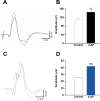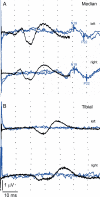4-aminopyridine improves evoked potentials and ambulation in the taiep rat: A model of hypomyelination with atrophy of basal ganglia and cerebellum
- PMID: 38427650
- PMCID: PMC10906851
- DOI: 10.1371/journal.pone.0298208
4-aminopyridine improves evoked potentials and ambulation in the taiep rat: A model of hypomyelination with atrophy of basal ganglia and cerebellum
Abstract
The taiep rat is a tubulin mutant with an early hypomyelination followed by progressive demyelination of the central nervous system due to a point mutation in the Tubb4a gene. It shows clinical, radiological, and pathological signs like those of the human leukodystrophy hypomyelination with atrophy of the basal ganglia and cerebellum (H-ABC). Taiep rats had tremor, ataxia, immobility episodes, epilepsy, and paralysis; the acronym of these signs given the name to this autosomal recessive trait. The aim of this study was to analyze the characteristics of somatosensory evoked potentials (SSEPs) and motor evoked potentials (MEPs) in adult taiep rats and in a patient suffering from H-ABC. Additionally, we evaluated the effects of 4-aminopyridine (4-AP) on sensory responses and locomotion and finally, we compared myelin loss in the spinal cord of adult taiep and wild type (WT) rats using immunostaining. Our results showed delayed SSEPs in the upper and the absence of them in the lower extremities in a human patient. In taiep rats SSEPs had a delayed second negative evoked responses and were more susceptible to delayed responses with iterative stimulation with respect to WT. MEPs were produced by bipolar stimulation of the primary motor cortex generating a direct wave in WT rats followed by several indirect waves, but taiep rats had fused MEPs. Importantly, taiep SSEPs improved after systemic administration of 4-AP, a potassium channel blocker, and this drug induced an increase in the horizontal displacement measured in a novelty-induced locomotor test. In taiep subjects have a significant decrease in the immunostaining of myelin in the anterior and ventral funiculi of the lumbar spinal cord with respect to WT rats. In conclusion, evoked potentials are useful to evaluate myelin alterations in a leukodystrophy, which improved after systemic administration of 4-AP. Our results have a translational value because our findings have implications in future medical trials for H-ABC patients or with other leukodystrophies.
Copyright: © 2024 Eguibar et al. This is an open access article distributed under the terms of the Creative Commons Attribution License, which permits unrestricted use, distribution, and reproduction in any medium, provided the original author and source are credited.
Conflict of interest statement
The authors have declared that no competing interest exist.
Figures









Similar articles
-
MRI Features in a Rat Model of H-ABC Tubulinopathy.Front Neurosci. 2020 Jun 3;14:555. doi: 10.3389/fnins.2020.00555. eCollection 2020. Front Neurosci. 2020. PMID: 32581692 Free PMC article.
-
A mutation in the Tubb4a gene leads to microtubule accumulation with hypomyelination and demyelination.Ann Neurol. 2017 May;81(5):690-702. doi: 10.1002/ana.24930. Epub 2017 May 9. Ann Neurol. 2017. PMID: 28393430 Free PMC article.
-
Longitudinal Evaluation of Cerebellar Signs of H-ABC Tubulinopathy in a Patient and in the taiep Model.Front Neurol. 2021 Jul 14;12:702039. doi: 10.3389/fneur.2021.702039. eCollection 2021. Front Neurol. 2021. PMID: 34335454 Free PMC article.
-
[A report of atypical hypomyelinating leukodystrophy with atrophy of the basal ganglia and cerebellum caused by a de novo mutation in tubulin beta 4A (TUBB4A) gene and literature review].Zhonghua Nei Ke Za Zhi. 2017 Jun 1;56(6):433-437. doi: 10.3760/cma.j.issn.0578-1426.2017.06.009. Zhonghua Nei Ke Za Zhi. 2017. PMID: 28592043 Review. Chinese.
-
An update on clinical, pathological, diagnostic, and therapeutic perspectives of childhood leukodystrophies.Expert Rev Neurother. 2020 Jan;20(1):65-84. doi: 10.1080/14737175.2020.1699060. Epub 2019 Dec 12. Expert Rev Neurother. 2020. PMID: 31829048 Review.
References
-
- Holmgren B, Urbá-Holmgren R, Riboni L, Vega-SaenzdeMiera EC. Sprague Dawley rat mutant with tremor, ataxia, tonic immobility episodes, epilepsy and paralysis. Laboratory Animal Science. 1989;39(3):226–228. - PubMed
MeSH terms
Substances
Supplementary concepts
LinkOut - more resources
Full Text Sources

